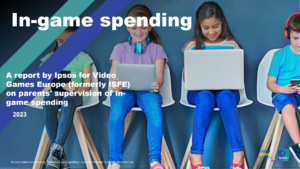In-Game Purchases in European Markets
Since 2018, Ipsos have conducted research looking at in game spending by children and parents' supervision of this spending. This is the fourth edition of the survey, conducted in 2018, 2019, 2020 and 2023.
The key take outs from the 2023 survey are:
- The proportion of parents claiming their children don't spend on in-game extras remain stable. More than 3 in 4 parents (76%) claim their children don't spend on in-game extras within the video games they play.
- The majority of children (64%) spends between €1 - €20/month on average. This spending has increased by €6 per month amongst those who claim to spend, versus in 2020, in line with inflation.
- The most popular in-game extras categories are content that either impact gameplay or are decorative or cosmetic. The most popular content is the one that impacts gameplay (34%), with just under one third of those who spend on in-game extras do so on decorative or cosmetic items (which do not impact gameplay). Unknown rewards, such as Loot Boxes, are less popular.
- The number of parents of children who spent on in-game extras AND have an agreement on spend levels remains high. 9 in 10 parents of children who spend on in-game extras have some kind of an agreement with their children about their spending. Half (506) have an explicit agreement with their children, either asking permissions (38%) or setting spending limits (23%)
- Most video game players don't engage with, or are not aware of in-game currency purchasing nor loot boxes. Just 9% claim to have spent real money on in-game currency and less than 4% on loot boxes.


